Global Distribution of Persistence of Total Electron Content Anomaly
Abstract
1. Introduction
2. Data and Methodology
3. Results
4. Discussion
5. Conclusions
Author Contributions
Funding
Acknowledgments
Conflicts of Interest
References
- Kelley, M.C. The Earth’s Ionosphere: Plasma Physics and Electrodynamics, 2nd ed.; Academic Publishers: San Diego, CA, USA, 2009; ISBN 978-0-1208-8425-4. [Google Scholar]
- Sun, Y.Y.; Matsuo, T.; Eduardo, E.A.; Liu, J.Y. Ground-based GPS observation of SED-associated irregularities over CONUS. J. Geophys. Res. Space Phys. 2013, 118, 2474–2489. [Google Scholar] [CrossRef]
- Sun, Y.Y.; Liu, J.Y.; Lin, C.H.; Lin, C.Y.; Shen, M.H.; Chen, C.H.; Chen, C.H.; Chou, M.Y. Ionospheric bow wave induced by the moon shadow ship over the continent of United States on 21 August 2017. Geophys. Res. Lett. 2018, 45, 538–544. [Google Scholar] [CrossRef]
- Liu, J.Y.; Chen, Y.I.; Chen, C.H.; Liu, C.Y.; Chen, C.Y.; Nishihashi, M.; Li, J.Z.; Xia, Y.Q.; Oyama, K.I.; Hattori, K.; et al. Seismoionospheric GPS total electron content anomalies observed before the 12 May 2008 Mw7.9 Wenchuan earthquake. J. Geophys. Res. 2009, 114, A04320. [Google Scholar] [CrossRef]
- Liu, J.Y.; Chen, Y.I.; Chen, C.H.; Hattori, K. Temporal and spatial precursors in the ionospheric global positioning system (GPS) total electron content observed before the 26 December 2004 M9.3 Sumatra–Andaman Earthquake. J. Geophys. Res. 2010, 115, A09312. [Google Scholar] [CrossRef]
- Liu, J.Y.; Le, H.; Chen, Y.I.; Chen, C.H.; Liu, L.; Wan, W.; Su, Y.Z.; Sun, Y.Y.; Lin, C.H.; Chen, M.Q. Observations and simulations of seismoionospheric GPS total electron content anomalies before the 12 January 2010 M7 Haiti earthquake. J. Geophys. Res. 2011, 116, A04302. [Google Scholar] [CrossRef]
- Liu, J.Y.; Hattori, K.; Chen, Y.I. Application of Total Electron Content Derived from the Global Navigation Satellite System for Detecting Earthquake Precursors. In Pre-Earthquake Processes: A Multidisciplinary Approach to Earthquake Prediction Studies; Ouzounov, D., Pulinets, S., Hattori, K., Taylor, P., Eds.; John Wiley & Sons: Hoboken, NJ, USA, 2018; pp. 305–317. ISBN 978-1-1191-5693-2. [Google Scholar]
- Sun, Y.Y.; Liu, J.Y.; Tsai, H.F.; Krankowski, A. Global ionosphere map constructed by using total electron content from ground-based GNSS receiver and FORMOSAT-3/COSMIC GPS occultation experiment. GPS Solut. 2017, 21, 1583–1591. [Google Scholar] [CrossRef]
- Schaer, S. Mapping and Predicting the Earth’s Ionosphere Using the Global Positioning System; Geodätisch-Geophysikalische Arbeiten in der Schweiz; Schweizerische Geodätische Kommission: Zürich, Switzerland, 1999; Volume 59. [Google Scholar]
- Kotz, S.; Johnson, N.L. Encyclopedia of Statistical Sciences; John Wiley & Sons: Hoboken, NJ, USA, 1983. [Google Scholar]
- Yen, H.Y.; Chen, C.H.; Yeh, Y.H.; Liu, J.Y.; Lin, C.R.; Tsai, Y.B. Geomagnetic fluctuations during the 1999 Chi-Chi earthquake in Taiwan. Earth Planets Space 2004, 56, 39–45. [Google Scholar] [CrossRef]
- Chen, C.H.; Lin, C.H.; Wang, C.H.; Liu, J.Y.; Yeh, T.K.; Yen, H.Y.; Lin, T.W. Potential relationships between seismo-deformation and seismo-conductivity anomalies. J. Asian Earth Sci. 2015, 114, 327–337. [Google Scholar] [CrossRef]
- Liu, J.Y.; Tsai, Y.B.; Chen, C.H.; Chen, Y.I.; Yen, H.Y. Integrated, Search for Taiwan Earthquake Precursors (iSTEP). IEEJ Trans. Fundam. Mater. 2016, 136, 214–220. [Google Scholar] [CrossRef]
- Tsai, Y.B.; Liu, J.Y.; Shin, T.C.; Yen, H.Y.; Chen, C.H. Multidisciplinary Earthquake Precursor Studies in Taiwan: A Review and Future Prospects. In Pre-Earthquake Processes: A Multidisciplinary Approach to Earthquake Prediction Studies; Ouzounov, D., Pulinets, S., Hattori, K., Taylor, P., Eds.; John Wiley & Sons: Hoboken, NJ, USA, 2018; pp. 41–65. ISBN 978-1-1191-5693-2. [Google Scholar]
- Sun, Y.Y.; Oyama, K.I.; Liu, J.Y.; Jhuang, H.K.; Cheng, C.Z. The neutral temperature in the ionospheric dynamo region and the relation with the ionospheric density during Wenchuan and Pingtung earthquakes. Nat. Hazard. Earth Syst. Sci. 2011, 11, 1759–1768. [Google Scholar] [CrossRef]
- Oyama, K.I.; Chen, C.H.; Bankov, L.; Minakshi, D.; Ryu, K.; Liu, J.Y.; Liu, H. Precursor effect of March 11, 2011 off the coast of Tohoku earthquake on high and low latitude ionospheres and its possible disturbing mechanism. Adv. Space Res. 2019, 63, 2623–2637. [Google Scholar] [CrossRef]
- Liu, J.Y.; Chen, Y.I.; Huang, C.C.; Parrot, M.; Shen, X.H.; Pulinets, S.A.; Yang, Q.S.; Ho, Y.Y. A spatial analysis on seismo-ionospheric anomalies observed by DEMETER during the 2008 M8.0 Wenchuan earthquake. J. Asian Earth Sci. 2015, 114, 414–419. [Google Scholar] [CrossRef]
- Ryu, K.; Oyama, K.I.; Bankov, L.; Chen, C.H.; Devi, M.; Liu, H.; Liu, J.Y. Precursory enhancement of EIA in the morning sector: Contribution from mid-latitude large earthquakes in the north-east Asian region. Adv. Space Res. 2016, 57, 268–280. [Google Scholar] [CrossRef]
- Oyama, K.I.; Kakinami, Y.; Liu, J.Y.; Kamogawa, M.; Kodama, T. Reduction of electron temperature in low latitude ionosphere at 600 km before and after large earthquakes. J. Geophys. Res. 2008, 113, A11317. [Google Scholar] [CrossRef]
- Chen, C.H.; Huba, J.D.; Saito, A.; Lin, C.H.; Liu, J.Y. Theoretical study of the ionospheric Weddell Sea Anomaly using SAMI2. J. Geophys. Res. 2011, 116, A04305. [Google Scholar] [CrossRef]
- Chang, F.Y.; Liu, J.Y.; Chang, L.C.; Lin, C.H.; Chen, C.H. Three-dimensional electron density along the WSA and MSNA latitudes probed by FORMOSAT-3/COSMIC. Earthplanets Space 2015, 67(1), 1–8. [Google Scholar] [CrossRef]
- Sun, Y.Y.; Matsuo, T.; Maruyama, N.; Liu, J.Y. Field-aligned neutral wind bias correction scheme for global ionospheric modeling at midlatitudes by assimilating FORMOSAT-3/COSMIC hmF2 data under geomagnetically quiet conditions. J. Geophys. Res. Space Phys. 2015, 120, 3130–3149. [Google Scholar] [CrossRef]
- Lin, C.H.; Liu, C.H.; Liu, J.Y.; Chen, C.H.; Burns, A.G.; Wang, W. Midlatitude summer nighttime anomaly of the ionospheric electron density observed by FORMOSAT-3/COSMIC. J. Geophys. Res. 2010, 115, A03308. [Google Scholar] [CrossRef]
- Lin, C.H.; Hsiao, C.C.; Liu, J.Y.; Liu, C.H. Longitudinal structure of the equatorial ionosphere: Time evolution of the four-peaked EIA structure. J. Geophys. Res. 2009, 112, A12305. [Google Scholar] [CrossRef]
- Sun, Y.Y.; Liu, H.; Miyoshi, Y.; Liu, L.; Chang, L.C. El Niño-Southern Oscillation effect on quasi-biennial oscillations of temperature diurnal tides in the mesosphere and lower thermosphere. Earthplanets Space 2018, 70, 85. [Google Scholar] [CrossRef]
- Sun, Y.Y.; Liu, H.; Miyoshi, Y.; Chang, L.C.; Liu, L. El Niño–Southern Oscillation effect on ionospheric tidal/SPW amplitude in 2007–2015 FORMOSAT-3/COSMIC observations. Earthplanets Space 2019, 71, 35. [Google Scholar] [CrossRef]
- Ouzounov, D.; Pulinets, S.; Hattori, K.; Taylor, P. Pre-Earthquake Processes: A Multidisciplinary Approach to Earthquake Prediction Studies; John Wiley & Sons: Hoboken, NJ, USA, 2018; ISBN 978-1-1191-5693-2. [Google Scholar]
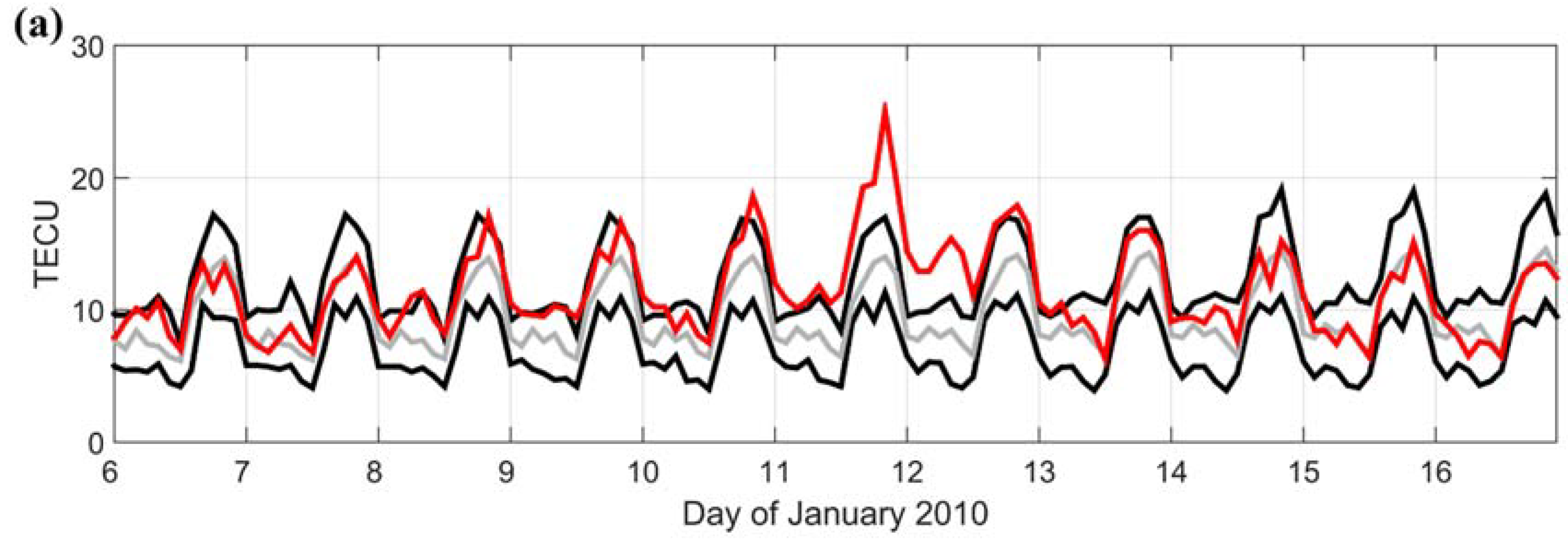
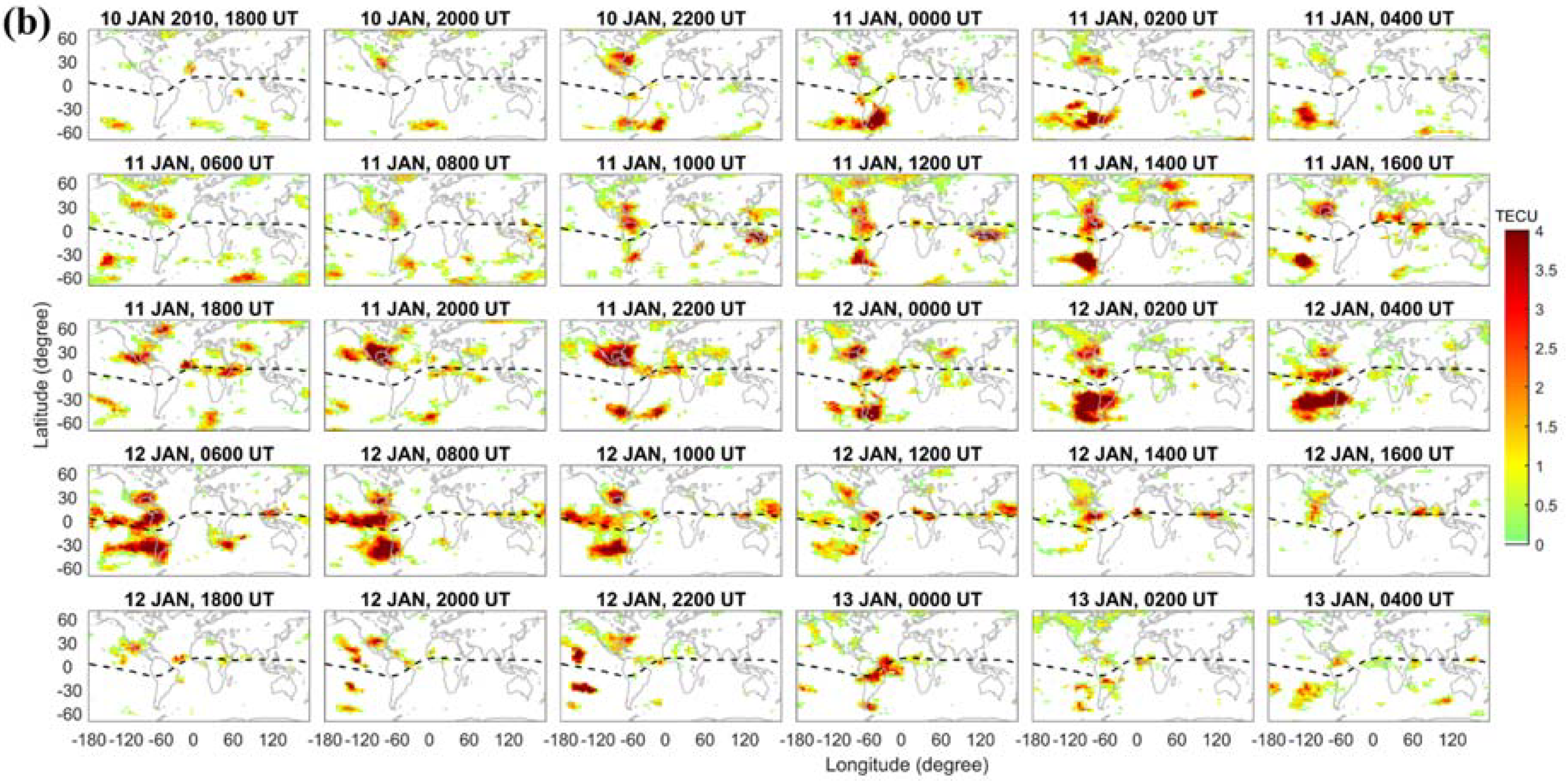
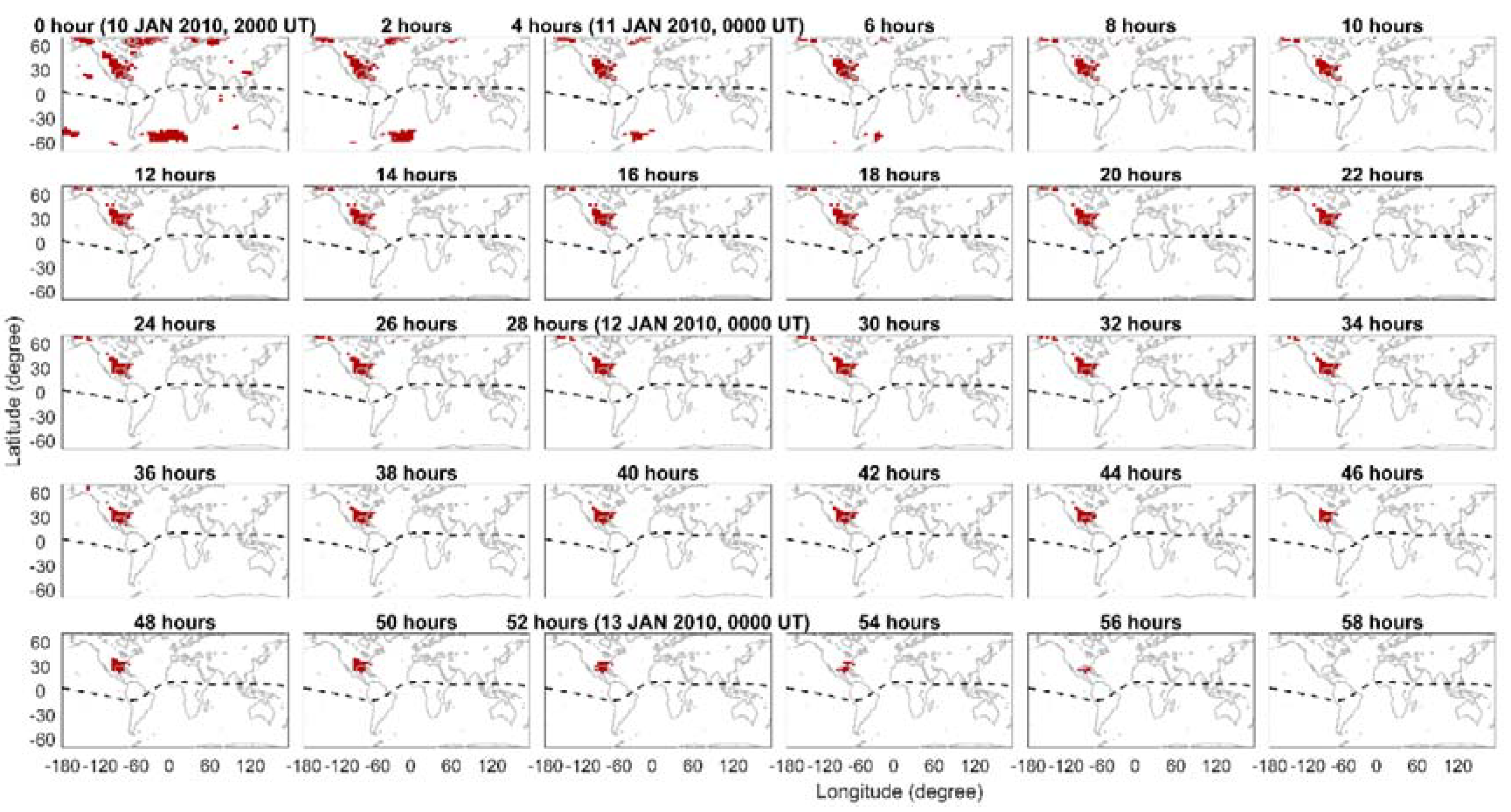
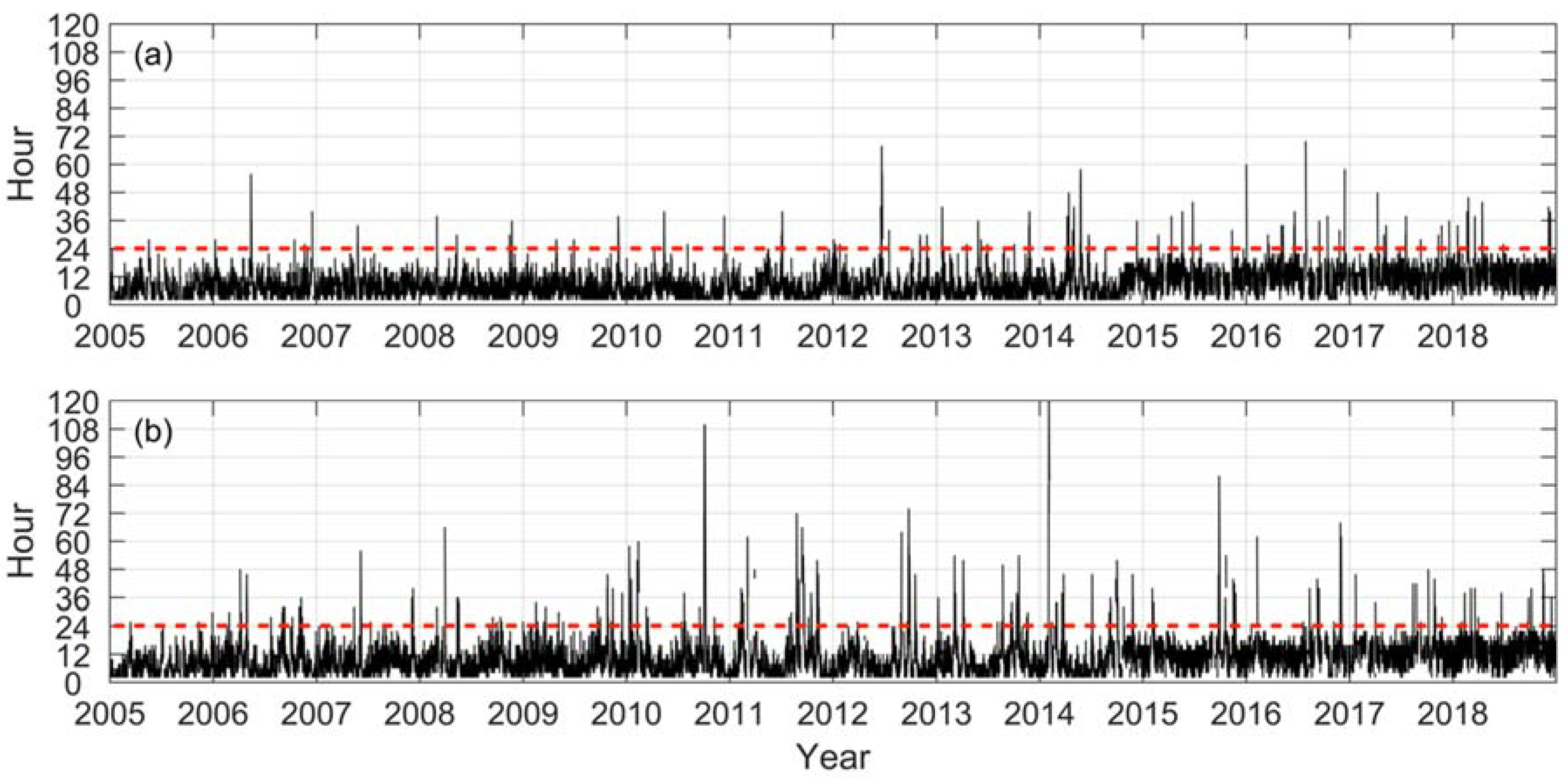
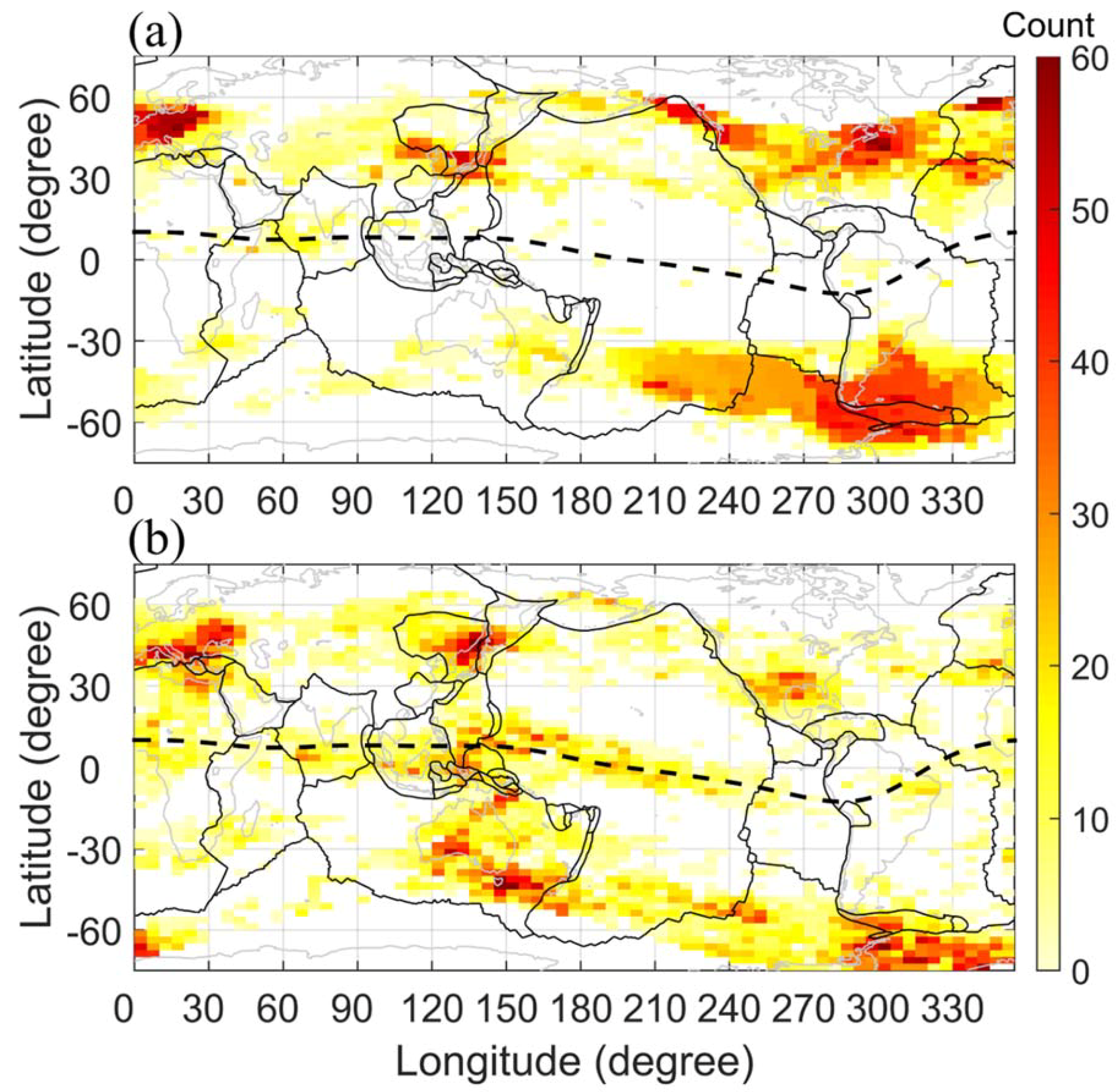
© 2019 by the authors. Licensee MDPI, Basel, Switzerland. This article is an open access article distributed under the terms and conditions of the Creative Commons Attribution (CC BY) license (http://creativecommons.org/licenses/by/4.0/).
Share and Cite
Sun, Y.-Y.; Liu, J.-Y.; Wu, T.-Y.; Chen, C.-H. Global Distribution of Persistence of Total Electron Content Anomaly. Atmosphere 2019, 10, 297. https://doi.org/10.3390/atmos10060297
Sun Y-Y, Liu J-Y, Wu T-Y, Chen C-H. Global Distribution of Persistence of Total Electron Content Anomaly. Atmosphere. 2019; 10(6):297. https://doi.org/10.3390/atmos10060297
Chicago/Turabian StyleSun, Yang-Yi, Jann-Yenq Liu, Tsung-Yu Wu, and Chieh-Hong Chen. 2019. "Global Distribution of Persistence of Total Electron Content Anomaly" Atmosphere 10, no. 6: 297. https://doi.org/10.3390/atmos10060297
APA StyleSun, Y.-Y., Liu, J.-Y., Wu, T.-Y., & Chen, C.-H. (2019). Global Distribution of Persistence of Total Electron Content Anomaly. Atmosphere, 10(6), 297. https://doi.org/10.3390/atmos10060297





